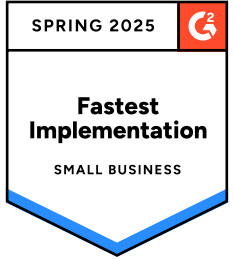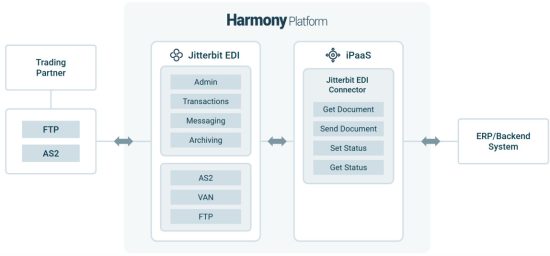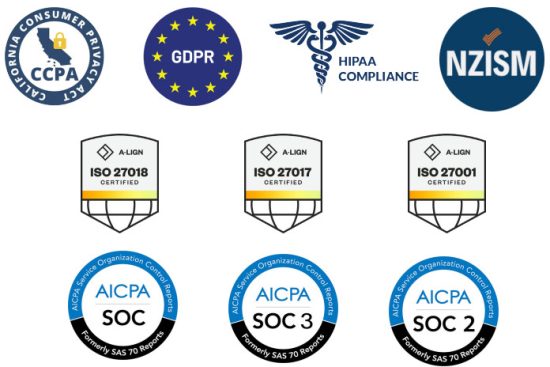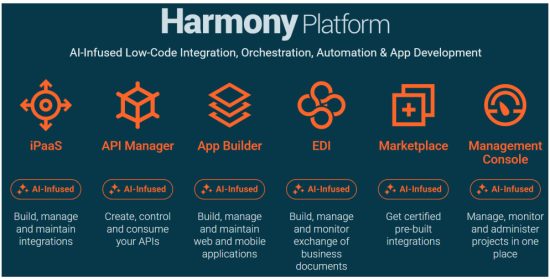
 A JITTERBIT GUIDE
A JITTERBIT GUIDE
The Complete
Guide to EDI
Proven Benefits of Jitterbit EDI
| 10.5 average months to ROI |
2.68 average months to go-live |
93% support agent rating |
| G2 Best Estimated ROI & Fastest Implementation EDI enterprise |
Major Player IDC Market scape B2B Middleware 2024 |
2024 Bronze Stevie Award business technology category |

 EDI: The Foundation of Modern Commerce
EDI: The Foundation of Modern Commerce
EDI continues to evolve as new technologies make new demands — and provide new and faster ways of communicating with trading partners, the supply chain and more.
Electronic Data Interchange (EDI) was created more than 40 years ago. But with today’s businesses facing an ever-growing list of challenges — from increased regulatory pressures and global digitization, to rising commerce volumes and resource constraints — it remains as relevant as ever.
EDI is the transfer of business documents between organizations in a standardized format. Businesses use EDI to simplify communications with trading and supply chain partners that regularly exchange goods or services.
The technology has continued to evolve alongside the changing business landscape, with EDI manufacturers incorporating AI and cloud technology advancements that boost productivity and help improve supply chain resilience. This innovation has fueled a market valued at $2.1 billion in 2024, and is expected to grow to $5.3 billion by 2032.¹
EDI: Everyone Does It
Today, an estimated 85% of supply chain transactions are managed through EDI.² With over 20 billion yearly transactions, EDI accounts for over $7 trillion in sales transaction value³, and most big-box retailers either require or strongly prefer EDI, including Amazon, Home Depot, Target, Walmart and more.
In other words, to begin or continue supplying your product to retailers and online marketplaces, your company will likely need to use EDI.
The Benefits of Using EDI
With EDI, back-and-forth transactions between retailers and suppliers happen electronically. That means, for example, that Costco can track purchase orders, ASNs, invoices and inventory — all without calling your warehouse.
The reasons for the near-universal adoption of EDI rest in its reliability, security, and ability to handle large transaction volumes without incident.
Beyond automation, EDI provides clear business value through cost savings and increased data accuracy.
By reducing errors, eliminating manual tasks and speeding up transactions, it helps organizations boost productivity and agility while responding more effectively to customer needs.
But that’s not the only reason to use EDI. In a highly competitive market, one misstep — an inaccurate inventory count or lack of adherence to guidelines — can result in losing a customer, or incurring penalties from retailers. EDI integration is key to meeting today’s increasingly demanding retail and manufacturing landscape.
The Typical EDI Transaction
To give you an idea of how EDI works, here’s a typical transaction in which your company is supplying goods to a retailer requiring EDI.
First, the retailer sends your company an EDI purchase order (PO), which goes into your ERP/ accounting system.
You respond with an EDI acknowledgement, letting the retailer know that the order will be fulfilled.
Next, you send an EDI advance shipping notice (ASN) containing information about what will be sent, when it will be sent, who the shipment will come from, and more.
Your shipping department then packs the product in containers or palettes depending on how and where the vendor or retailer wants you to ship the product.
Finally, you send an EDI invoice to the retailer. To confirm payment, the retailer’s accounting team will generate and send you an EDI remittance advice document. End-to-End EDI Order Processing and Fulfillment Integration
End-to-End EDI Order Processing and Fulfillment Integration  1. Order Initiation via EDI from Vendor
1. Order Initiation via EDI from Vendor
- The vendor initiates the process by sending purchase orders (POs) in EDI format (850) to the customer.
- These EDI orders are received by the customer’s Jitterbit EDI, where they are validated.
2. EDI to XML Transformation
- Upon successful receipt and validation, the EDI orders are transformed into a standardized EDIXml format to enable processing by Integration Studio.
3. Integration Through Integration Studio to ERP
- The XML-based order data is processed through Integration Studio, which orchestrates the end-to-end data flow.
- Integration Studio maps, transforms, and routes the order data into the ERP system.
- A new Sales Order record is created in the ERP with all relevant order details including customer information, items, quantities, and delivery preferences.
4. Fulfillment Request Sent to 3PL via API
- Once the Sales Order is confirmed in the ERP, the order is routed to a third-party logistics (3PL) provider for fulfillment.
- The integration with the 3PL is achieved via a REST API, which sends structured order data including item SKUs, quantities, shipping method, and destination.
5. Shipment and Tracking Updates Returned from 3PL
- After the 3PL processes the order and ships the items, it sends back a shipment confirmation, including tracking number(s) and carrier details, via the same API.
- This shipment data is received and updated in the ERP against the original Sales Order, closing the fulfillment loop internally.
6. Shipment Exported, Transformed, and Sent to Vendor via EDI
- The shipment and tracking details are exported from the ERP and processed again through the Integration Studio.
- The EDIXml is transformed back into EDI format, typically an EDI 856 (Advance Ship Notice).
- This EDI shipment confirmation is then sent to the vendor via Jitterbit EDI, providing them visibility into fulfillment and shipment status.
At every step of this process, automation of the order-to-fulfillment lifecycle reduces manual effort and errors. At the same time, it helps ensure you remain compliant with EDI standards.
Challenges in Using EDI
The wide range of EDI requirements, vendors, capabilities and use cases brings with it some complexity — and this complexity presents challenges for businesses that don’t fully understand their use cases or how to integrate their solution into their environment.
As a result, too many businesses are still relying on manual processes, despite adopting EDI. They’re spending too much time on data entry, correcting human error and struggling for visibility.
They may also be having trouble with:
- Onboarding, testing and managing trading partners without relying on EDI vendor
- Managing documents and approving/fixing transaction errors in one place
- Relying on outdated manual processes to transfer EDI data to back-end systems, ERP, etc.
- Adhering to complex trading partner guidelines, including multiple EDI formats
- Reporting and forecasting due to data silos that separate EDI data from other apps and ERP systems
- Ensuring interoperability/Integrating new applications and solutions with EDI as business grows
- Outgrowing existing EDI vendor, which lacks necessary features and functionalities to scale
- Fraud and compliance failures resulting from lack of data and operational security
- Managing EDI trading partners, integrations, etc. despite already having EDI expertise or an EDI team
- Managing integrations, users, etc. from a single location
 These issues aren’t just annoying: they’re likely limiting your growth. When EDI solutions fail to keep up, it affects suppliers, customers and your reputation. And when you can’t add new trading partners, it impacts your bottom line.
These issues aren’t just annoying: they’re likely limiting your growth. When EDI solutions fail to keep up, it affects suppliers, customers and your reputation. And when you can’t add new trading partners, it impacts your bottom line.
If you’re facing any of these challenges — if you’re frustrated with the value or support you’re getting from your current vendor, or have been avoiding adopting EDI in the first place — Jitterbit EDI can offer a more powerful, simple and reliable way forward.
![]() “As the market moved from wholesale to more marketplace-driven, we needed a versatile tool to connect to a wide variety of trading partners. Jitterbit allows us to meet our partners’ diverse demands for data and marketplace integration. The tool has scaled exceptionally well to meet our needs over the past six years.”
“As the market moved from wholesale to more marketplace-driven, we needed a versatile tool to connect to a wide variety of trading partners. Jitterbit allows us to meet our partners’ diverse demands for data and marketplace integration. The tool has scaled exceptionally well to meet our needs over the past six years.”
EDI Manager at Mid-Sized Furniture Distribution Company
Eight Reasons Why Jitterbit EDI Is Different
To remain competitive, businesses must overcome these challenges with an EDI solution that’s reliable, self-managed, fully integrated and equipped with a long list of established trading partner connections.
Jitterbit EDI offers full visibility of transactions, documents and trading partners via a single dashboard — letting you onboard, test, configure and manage more simply at every stage of the EDI lifecycle.
Here’s what sets Jitterbit EDI apart:
1. Enable B2B Workflows in a Single Platform
Jitterbit EDI seamlessly integrates with backend applications like ERP and ecommerce, unlocking transaction-level access to EDI data for your customer service team. It’s fully integrated into Jitterbit iPaaS, making it easy to scale, add new applications and integrate systems with EDI and outside
The Jitterbit Harmony platform offers a fully integrated suite of solutions that allows you to build, manage and monitor B2B transactions, build and manage APIs, create apps and more.
Because developers and admins have full access to the integration itself, you can leverage other Jitterbit solutions, like API Manager and App Builder, to build a seamless, end-to-end enterprise level solution — all without third-party applications, vendors or interventions.
While Jitterbit EDI works best as part of an overall platform strategy, it can also function as a standalone application, allowing you to receive EDI documents from your trading partners. For example, you can receive EDI documents from a trading partner directly into Jitterbit EDI, review the data, and then manually input the results into your back-end system.
THE DATA IS IN
By deploying Jitterbit EDI, businesses can expect to see:
- Up to a 90% lower cost per document than manual processing
- Reduction of transactional errors by up to 40%
- Lower transaction costs by up to 35%
- Reduction of order-to-cash cycle time by more than 20%
- Average 2.68 months to go-live
- Average 10.5 average months to ROI
 Rapid, follow-the-sun support from seasoned EDI professionals
Rapid, follow-the-sun support from seasoned EDI professionals
2. So Easy, Even a Novice Can Use It
Jitterbit EDI is designed to make adding and configuring new EDI trading partners easy.
You have complete access to trading partner settings and configurations, so you can effortlessly set up, test and monitor EDI trading partners and transactions on your own. And our list of 1,000+ pre-built trading partners, modern UI and intuitive dashboard make the process accessible even for nontechnical and novice users.
Best of all, while many EDI solutions only offer the ability to translate EDI data, Jitterbit EDI goes further— letting you integrate EDI into your entire tech stack and connect EDI to other applications for complex mapping and integrations.
See how easy it is to add a new trading partner or to manage existing trading partners.
3. Predictable Pricing. Unlimited Messages.
While small businesses may only process a few transactions per month, large retail companies and organizations can process as many as 10 million EDI transactions per day.
For those paying for EDI on a per-message basis, this can really add up.
Unlike most vendors, the cost for Jitterbit EDI is calculated on a per-trading-partner basis — no matter how many messages you send back and forth.
Best of all, you’ll always know exactly what you’ll pay, simplifying the budgeting process and avoiding surprises.
4. EDI Experts, At Your Service 
Although Jitterbit EDI is built to be a self-managed solution, we understand not everyone wants to manage setup and deployment on their own.
We’re happy to assist with your implementation — or with connecting you to ERP, SCM, CRM, eCommerce and other back-end systems.
What’s more, our direct EDI integration is backed by the highest level of support found in the B2B industry, and our support agents are currently rated at 93%.
Learn more about Jitterbit Enhanced Services and Premier Support.
5. Everyone Has Standards. We’ll Help You Meet Them All.
We’re experts at helping you adhere to trading partner guidelines, which is key for a seamless trading
partner relationship. From setup to testing to go-live, we make sure that you remain compliant with your EDI trading partner and can receive and process all essential documents. And with full visibility of the EDI process, you’ll be able to spot any issues before they cause problems.
6. AI-Driven Productivity — With Legacy Accountability
Jitterbit EDI is designed to be a future-proof solution, allowing you to leverage generative AI to accelerate the development, management and maintenance of B2B transactions. AI-driven insights can also help you optimize workflows, reduce errors and enhance supply chain visibility, ensuring efficient and accurate management of the entire B2B ecosystem.
But Jitterbit EDI is past-proof, as well. Because EDI has been around for so long, many companies have built their EDI processes and workflows around legacy ERP and other systems, and believe these archaic tools cannot be integrated into today’s technology. That’s where Jitterbit can help. We can integrate legacy systems with current popular business applications such as Salesforce or Netsuite, allowing you to seamlessly combine the new features you want with the tried-and-true tools that are still serving you well — regardless of whether these systems are on-prem or in the cloud. 7. A Smoother Experience, With No Separate Services
7. A Smoother Experience, With No Separate Services
When it comes time for a business to use EDI, they often find that solution providers offer it as a separate service. The majority of the time, this will require that the solution provider sets up and tests within their network.
This is because many vendors don’t have EDI capabilities native to their platform. They use a third-party offering, which requires a greater degree of intervention, creates more points of failure and introduces unnecessary complexity.
Jitterbit owns its own translators, and we’ve built them directly into our solution — ensuring a more simpleand seamless experience.
8. Better Security, for Better Peace of Mind
Jitterbit EDI adheres to stringent standards, compliances and industry regulations. To ensure the greatest degree of security, it’s built with the following features:
- PII Protection: Administrators can enable PII to mask personal user information, as well as Delete and Purge documents.
- Archiving: Transactions are automatically archived on an ongoing basis, while supporting unlimited retention of records for ensured compliance
- Encryption, at rest and in motion: Data encryption helps safeguard against potential data breaches and unauthorized access
- Global Accreditation & Compliance: As part of the Jitterbit Harmony platform, Jitterbit EDI has been accredited by or certified to be compliant with the following global security standards:

Jitterbit EDI Case Studies
Want to know more about how Jitterbit EDI is helping businesses like yours save time
and money? Here are three Jitterbit EDI case studies:
 Health & Beauty Manufacturer Demystifies EDI and Increases Control with Jitterbit
Health & Beauty Manufacturer Demystifies EDI and Increases Control with Jitterbit
Jitterbit EDI made it simple to not only see and understand how the system worked, but also to add trading partners or make changes themselves.
The introduction of EDI to XML a little while later made these processes even faster and easier.
![]() It’s been great to work with. I work with Jitterbit basically all day, every day, so getting everything in one platform — and being able to visualize it all on my interface — has been great for me.”
It’s been great to work with. I work with Jitterbit basically all day, every day, so getting everything in one platform — and being able to visualize it all on my interface — has been great for me.”
— Tom Potkins, Systems Integration Developer
How Idea Village integrates Microsoft Dynamics GP to automate EDI workflows
For each trading partner, the solution was configured to retrieve outbound documents from MS Dynamics GP, convert them into an EDI format, and send them to the partner for processing. Inbound EDI documents from each trading partner were set up to be retrieved, translated and imported into MS Dynamics GP.
![]() Our company receives thousands of orders a week, and without implementing an EDI solution, we would never have been able to keep up with our orders moving forward.”
Our company receives thousands of orders a week, and without implementing an EDI solution, we would never have been able to keep up with our orders moving forward.”
— Alfredo Sanoguel, IT Director/EDI Coordinator
Topcon Positioning Group Grows with EDI
With Jitterbit EDI, Topcon replaced manual, time-consuming order processing with fully automated workflows.
![]() We’ve saved countless hours that people spent working manually on orders. Showing our partners that we can process orders quickly and efficiently creates faith in our brand and opportunities to grow our business.”
We’ve saved countless hours that people spent working manually on orders. Showing our partners that we can process orders quickly and efficiently creates faith in our brand and opportunities to grow our business.”
— David Vopnford, Application Delivery Manager
Serving Every Industry with Industry-Leading EDI
Sectors such as healthcare, retail and manufacturing are seeing strong returns on investment, making EDI a cornerstone of digital infrastructure for businesses aiming to stay competitive and future-ready.
- Retail: Retailers use Jitterbit EDI to exchange purchase orders, invoices and advance shipping notices with their suppliers. This streamlines the ordering process and enhances inventory management.
- Manufacturing: The manufacturing sector relies on Jitterbit EDI for managing supply chain operations, such as sending purchase orders, shipping notifications and invoices between manufacturers, suppliers and distributors.
- Logistics and Transportation: Jitterbit EDI is extensively used in logistics and transportation for exchanging shipping and tracking information, customs documentation, freight invoices and load tendering.
- Automotive: The automotive industry uses Jitterbit EDI for managing supply chain processes, such as exchanging purchase orders, shipping notifications, invoices and more between automobile manufacturers, suppliers and distributors.
- Finance and Banking: Financial institutions use Jitterbit EDI for secure transmission of financial messages, including electronic funds transfers (EFTs), bank statements, finance applications and payment orders between banks, corporations and other financial entities.
- Telecommunications: Telecommunication companies employ Jitterbit EDI for managing the provisioning of services, exchanging service orders, billing information and customer updates between service providers and network operators.
- Energy and Utilities: Jitterbit EDI is used in the energy and utilities sector for handling billing, metering data and service requests between utility companies, suppliers, and customers.
Regardless of your line of work, Jitterbit EDI can help streamline transactions, automate workflows and accelerate new trading partner connections — all on one enterprise platform. For a demo tailored to your specific industry or use case, contact us.
![]() “The combination of features and ease of use allows rapid development, testing and release of EDI integrations. We integrate with our customers and entire supply chain via EDI communications. Jitterbit provides the translation engine that makes it possible for us to create and maintain those integrations internally, making it faster and more cost-effective.”
“The combination of features and ease of use allows rapid development, testing and release of EDI integrations. We integrate with our customers and entire supply chain via EDI communications. Jitterbit provides the translation engine that makes it possible for us to create and maintain those integrations internally, making it faster and more cost-effective.”
— Advisor at Small Financial Company
A Deeper Dive Into Jitterbit EDI Features
Jitterbit EDI includes a number of features designed to provide a robust, simple and seamless EDI experience:
EDI Administration
- Add, create and edit trading partners without the need to submit a request
- Create workflows that use EDI directly instead of relying on maps, which makes the process more streamlined
- Remove the need for additional software or service costs by including VAN, AS2, SFTP and FTP connections
Transaction Management
- Allow non-technical users to effortlessly monitor and manage their EDI transactions
- Easily locate any EDI transaction with our advanced search option
- Gain full visibility by allowing the downloading, printing and copying of both the native and transformed EDI transactions
Intuitive User Experience
- Decoupled EDI solution from the integration layer, allowing nontechnical business users access to what they require
- EDI management for the modern era with an easy-to-follow user interface not found in other
- EDI solutions
Messaging and Logging Transactions
- Message logging at the transaction level helps during testing cycles
- Identify issues related to communication loss and transaction processing easily
- Message Queue controls when EDI docs are processed and released
Transaction Archiving
- Manage the frequency of transaction archiving for each trading partner, and let the system automate the process for you
- Provide an easy way for users to locate and restore archived transactions
- Leverage an unlimited retention of archived transactions to better meet compliance
Trading Partner Communications
- Secure data during transmissions to protect sensitive information and meet industry guidelines
- Achieve data exchange consistency and reliability with automation to minimize errors and delays when responding to trading partners
- Orchestrate seamless integration and data synchronization between systems to enhance the efficiency and accuracy of trading partners’ communications
Security and PII
- Trading partners segregated by environment
- Transaction encryption at rest and during transmission
- PII masking on all transaction data
- Permanently delete documents
- Remove all content from selected documents
Integration Studio
- Built-in EDI connector allows access to your EDI partners and documents
- View and manage EDI integration activities, and audit logging and notifications from Integration Studio
Document Types, Standards & Communication Methods
Jitterbit EDI supports a wide range of EDI document types. An up-to-date list is located here.
| Data Formats | X12, EDIFACT, TRADACOMS |
| Transport Protocols | AS2, VAN, FTP/SFTP |
| Platforms | Cloud, Windows, Linux, Solaris |
| Enterprise Applications | SAP, Microsoft Dynamics, Oracle, JD Edwards, and more |
| Databases | Oracle, SQL Server, DB2, MySQL, Sybase, Teradata, and more |
| Existing SOA Platforms | web Methods, Tibco, IBM WebSphere, BEA WebLogic, and more |
| 3rd Party Applications | QAD, Infor, Vertical Response, Interwoven, AMS Advantage, Microsoft SharePoint, Documentum, Amazon.com, and more |
| SaaS Applications | Salesforce, NetSuite, Workday, ServiceNow, Zendesk and more |
| Other Systems | Web Services, XML, Flat and Hierarchical Structures, Legacy, Active Directory, LDAP and more |
Jitterbit regularly adds capabilities, compatibilities and features to its products. As a result, this list may not be all-inclusive. Please contact us for the latest on document types, standards, communication methods and more.
Explore the Full Harmony Platform
Jitterbit EDI integrates seamlessly with the other solutions in Jitterbit’s AI-infused Harmony platform: 1. https://www.fortunebusinessinsights.com/electronic-data-interchange-edi-software-market-103690
1. https://www.fortunebusinessinsights.com/electronic-data-interchange-edi-software-market-103690
2. https://www.ibm.com/think/insights/edi-with-apis-makes-supply-chain-sense
3. https://www.digitalcommerce360.com/2020/06/01/why-edi-still-has-a-big-role-to-play-in-b2b-ecommerce/
About Jitterbit
Jitterbit provides a unified, AI-infused low-code platform for integration, orchestration, automation, and app development. By delivering greater productivity and value, the Jitterbit Harmony platform future-proofs operations, simplifies complexity and drives innovation for organizations globally.
 Learn more at jitterbit.com
Learn more at jitterbit.com
Connect with Us:![]()
Documents / Resources
 |
Jitterbit Harmony Data Integration Best Practices [pdf] User Guide Harmony Data Integration Best Practices, Harmony, Data Integration Best Practices, Integration Best Practices, Best Practices |